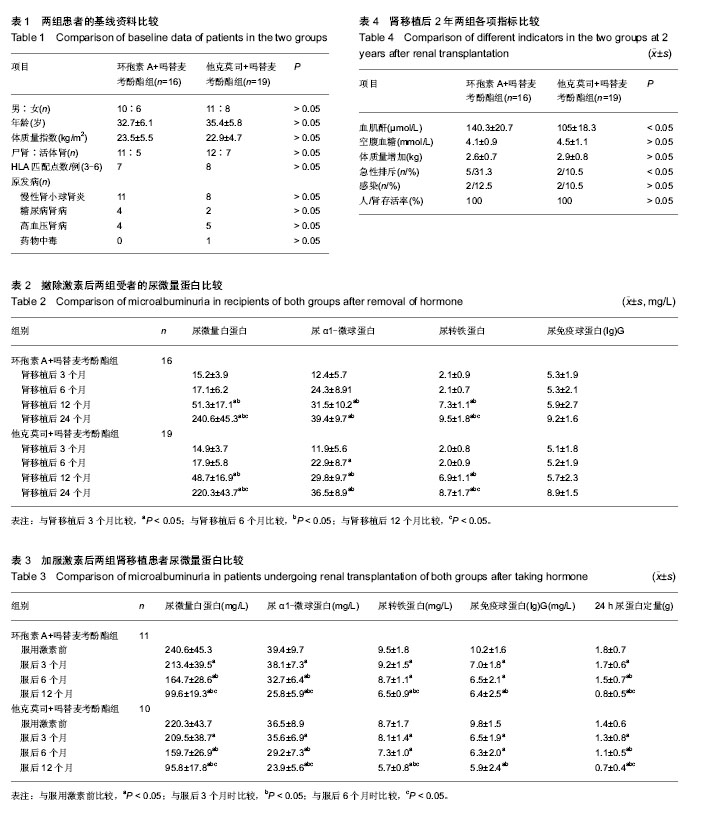| [1] Hoban R, Gielda B, Temkit M,et al.Utility of HbA1c in the detection of subclinical post renal transplant diabetes. Transplantation. 2006;81(3):379-383.
[2] Ahmadpoor P, Reisi S, Makhdoomi K,et al.Osteoporosis and related risk factors in renal transplant recipients.Transplant Proc. 2009;41(7):2820-2822.
[3] Giakoustidis D, Antoniadis A, Fouzas I, et al.Prevalence and clinical impact of cytomegalovirus infection and disease in renal transplantation: ten years of experience in a single center. Transplant Proc. 2012;44(9):2715-2717.
[4] 陈国标,陈立中,陈白莉,等.低剂量激素方案在肾移植中应用的疗效和安全性[J].中华肾脏病杂志,2009,25(12):948-949.
[5] 刘双德,王洪伟,田川,等.中老年肾移植患者早期撤除激素的免疫抑制方案研究[J].中华老年医学杂志,2010,29(1):42-45.
[6] Knight SR, Morris PJ.Steroid avoidance or withdrawal after renal transplantation increases the risk of acute rejection but decreases cardiovascular risk. A meta-analysis. Transplantation. 2010;89(1):1-14.
[7] Pascual J, Galeano C, Royuela A,et al.A systematic review on steroid withdrawal between 3 and 6 months after kidney transplantation.Transplantation. 2010;90(4):343-349.
[8] Sprangers B, Vanrenterghem Y.Steroid avoidance or withdrawal after kidney transplantation: a balancing act. Transplantation. 2010;90(4):350-352.
[9] Knight SR, Morris PJ.Steroid avoidance or withdrawal in renal transplantation. Transplantation. 2011;91(5):e25-27.
[10] Zhang X, Huang H, Han S, et al. Is it safe to withdraw steroids within seven days of renal transplantation. Clinical Transplantation. 2013;27(1):1-8.
[11] 眭维国.高致敏人群肾移植急性排斥反应的综合预防[J].器官移植内科学杂志,2012,7(4):162-165.
[12] 郭义峰.肾移植术后急性排斥反应的治疗和预防[J].中华临床医师杂志:电子版,2013,7(1):6-7.
[13] Halloran PF. Immunosuppressive drugs for kidney transplantation. N Engl J Med. 2004;351(26):2715-2729.
[14] 武国军,王禾,于磊,等.联合霉酚酸酯、环孢素A和泼尼松应用于肾移植患者免疫抑制治疗[J].中国现代医学杂志,2006,16(17): 2640-2642.
[15] 韦星,蔡明,李州利,等. 甲泼尼龙治疗肾移植后的重症肺部感染[J].中国组织工程研究,2014,18(5):742-747.
[16] Pascual J, van Hooff JP, Salmela K,et al.Three-year observational follow-up of a multicenter, randomized trial on tacrolimus-based therapy with withdrawal of steroids or mycophenolate mofetil after renal transplant.Transplantation. 2006;82(1):55-61.
[17] Nowacka-Cieciura E, Soluch L, Cieciura T,et al.Effect of glucocorticoid-free immunosuppressive protocol on serum lipids in renal transplant patients.Transplant Proc. 2000; 32(6):1339-1343.
[18] Pascual J, Zamora J, Galeano C,et al.Steroid avoidance or withdrawal for kidney transplant recipients. Cochrane Database Syst Rev. 2009;(1):CD005632.
[19] 刘双德,王洪伟,田川,等.中老年肾移植患者早期撤除激素的免疫抑制方案研究[J].中华老年医学杂志,2010,29(1):42-45.
[20] 张益民,李幼姬.肾移植后不用或撤除糖皮质激素的利弊[J].中国中西医结合肾病杂志,2010,11(3):191.
[21] 曲青山,蔡文利,苗书斋,等.撤除激素的肾移植免疫抑制方案研究[J].医药论坛杂志,2006,27(9):23-24.
[22] Woodle ES, Peddi VR, Tomlanovich S,et al.A prospective, randomized, multicenter study evaluating early corticosteroid withdrawal with Thymoglobulin in living-donor kidney transplantation.Clin Transplant. 2010;24(1):73-83.
[23] Sandrini S, Setti G, Bossini N,et al.Early (fifth day) vs. late (sixth month) steroid withdrawal in renal transplant recipients treated with Neoral(®) plus Rapamune(®): four-yr results of a randomized monocenter study.Clin Transplant.2010;24(5):669-677.
[24] Tan JY, Zhao N, Wu TX,et al.Steroid withdrawal increases risk of acute rejection but reduces infection: a meta-analysis of 1681 cases in renal transplantation.Transplant Proc. 2006; 38(7):2054-2056.
[25] Vincenti F, Monaco A, Grinyo J,et al.Multicenter randomized prospective trial of steroid withdrawal in renal transplant recipients receiving basiliximab, cyclosporine microemulsion and mycophenolate mofetil.Am J Transplant.2003;3(3):306-311.
[26] Gelens MA, Christiaans MH, van Heurn EL,et al.High rejection rate during calcineurin inhibitor-free and early steroid withdrawal immunosuppression in renal transplantation. Transplantation. 2006;82(9):1221-1223.
[27] Laftavi MR, Stephan R, Stefanick B,et al.Randomized prospective trial of early steroid withdrawal compared with low-dose steroids in renal transplant recipients using serial protocol biopsies to assess efficacy and safety.Surgery. 2005; 137(3):364-371.
[28] 刘龙山,刘岩峰,邓荣海,等. 肾移植后稳定期受者撤除皮质激素的临床研究[J].中华器官移植杂志,2013,34(11):643-646.
[29] 姜伟,刘彦斌,裴向克,等.肾移植术后重症肺炎撤除免疫抑制剂治疗的安全性评估[J].实用器官移植电子杂志,2013,1(4):229-231.
[30] 张晓君,蒲晓煜,陈国勇,等.免疫抑制剂撤除治疗肝移植术后重症感染[J].中华普通外科杂志,2012,27(11):927-930.
[31] Favi E, Spagnoletti G, Salerno MP,et al.Tacrolimus plus mycophenolate mofetil vs. cyclosporine plus everolimus in deceased donor kidney transplant recipients: three-yr results of a single-center prospective clinical trial.Clin Transplant. 2013; 27(4):E359-367.
[32] Cooper M, Salvadori M, Budde K,et al.Enteric-coated mycophenolate sodium immunosuppression in renal transplant patients: efficacy and dosing.Transplant Rev (Orlando). 2012;26(4):233-240.
[33] Khalkhali HR, Ghafari A, Hajizadeh E,et al.Risk factors of long-term graft loss in renal transplant recipients with chronic allograft dysfunction.Exp Clin Transplant. 2010;8(4):277-282.
[34] 林超萍,潘洁茹,吕婉娴.血清胱蛋白酶抑制剂c在肾移植中的临床意义[J].实用医技杂志,2008,15(9):1096-1097.
[35] Andersson L, Haraldsson B, Johansson C,et al. Methodological issues on the use of urinary alpha-1-microglobuline in epidemiological studies.Nephrol Dial Transplant. 2008;23(4):1252-1256.
[36] Groggel C,Stevenson J,Hovingh P,et al.Changes in heparin sulfate correlate with increased glomerular permeability. Kidney International.1988;33(2):517-523.
[37] 黎磊石.中国肾移植手册[M].Philadelphia:Lippincott Williams &Wilkins,2005:205.
[38] Pascual M, Theruvath T, Kawai T,et al.Strategies to improve long-term outcomes after renal transplantation.N Engl J Med. 2002;346(8):580-590.
[39] 吴斌,苏兰,徐珽,等.他克莫司替代环孢素A防治移植物抗宿主病的Meta分析[J].中国医院药学杂志,2009,29(22):1957-1959.
[40] Krämer BK, Klinger M, Wlodarczyk Z, et al.Tacrolimus combined with two different corticosteroid-free regimens compared with a standard triple regimen in renal transplantation: one year observational results.Clin Transplant. 2010;24(1):E1-9.
[41] Rostaing L, Cantarovich D, Mourad G, et al. Corticosteroid-free immunosuppression with tacrolimus, mycophenolate mofetil, and daclizumab induction in renal transplantation.Transplantation. 2005;79(7):807-814.
[42] Bowman LJ, Brennan DC.The role of tacrolimus in renal transplantation.Expert Opin Pharmacother. 2008;9(4):635-643.
[43] Yong K, Nguyen HD, Hii L,et al.Association of a change in immunosuppressive regimen with hemodynamic and inflammatory markers of cardiovascular disease after kidney transplantation.Am J Hypertens. 2013;26(7):843-849.
[44] 邹贵勉, 眭维国,晏强,等.肾移植后高尿酸血症对移植肾远期功能的影响[J].解放军医学杂志, 2009,34(9):1108-1110.
[45] Wang W, Li XB, Yin H,et al.Factors affecting the long-term renal allograft survival.Chin Med J (Engl). 2011;124(8): 1181-1184.
[46] Huscher D, Thiele K, Gromnica-Ihle E, et al.Dose-related patterns of glucocorticoid-induced side effects. Ann Rheum Dis. 2009;68(7):1119-1124.
[47] 王建功.糖皮质激素受体及其在器官移植排斥反应中的作用[J].实用医药杂志,2004,21(6):570-572.
[48] Perogamvros I, Ray DW, Trainer PJ.Regulation of cortisol bioavailability--effects on hormone measurement and action.Nat Rev Endocrinol. 2012;8(12):717-727. |
